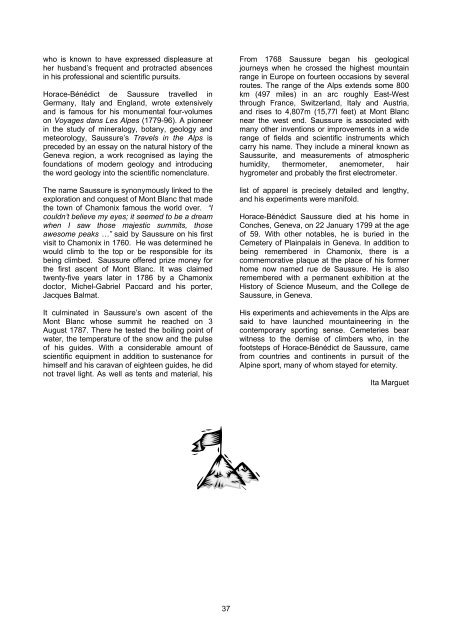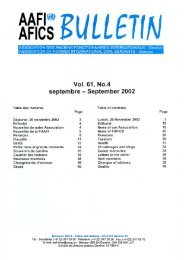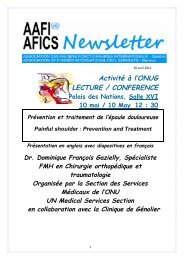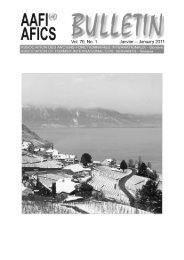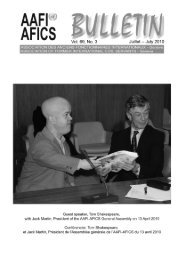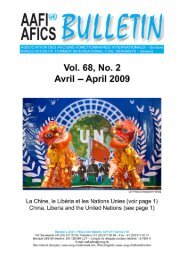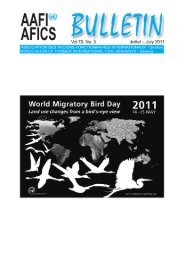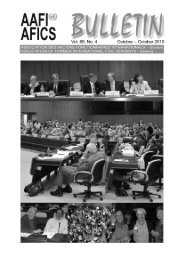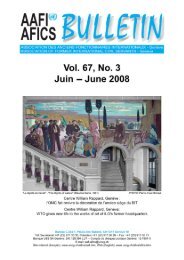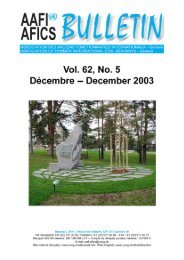VOL. 65, NO. 2 Mars â March 2006 - AAFI-AFICS, Geneva - UNOG
VOL. 65, NO. 2 Mars â March 2006 - AAFI-AFICS, Geneva - UNOG
VOL. 65, NO. 2 Mars â March 2006 - AAFI-AFICS, Geneva - UNOG
Create successful ePaper yourself
Turn your PDF publications into a flip-book with our unique Google optimized e-Paper software.
who is known to have expressed displeasure ather husband’s frequent and protracted absencesin his professional and scientific pursuits.Horace-Bénédict de Saussure travelled inGermany, Italy and England, wrote extensivelyand is famous for his monumental four-volumeson Voyages dans Les Alpes (1779-96). A pioneerin the study of mineralogy, botany, geology andmeteorology, Saussure’s Travels in the Alps ispreceded by an essay on the natural history of the<strong>Geneva</strong> region, a work recognised as laying thefoundations of modern geology and introducingthe word geology into the scientific nomenclature.The name Saussure is synonymously linked to theexploration and conquest of Mont Blanc that madethe town of Chamonix famous the world over. “Icouldn’t believe my eyes; it seemed to be a dreamwhen I saw those majestic summits, thoseawesome peaks …” said by Saussure on his firstvisit to Chamonix in 1760. He was determined hewould climb to the top or be responsible for itsbeing climbed. Saussure offered prize money forthe first ascent of Mont Blanc. It was claimedtwenty-five years later in 1786 by a Chamonixdoctor, Michel-Gabriel Paccard and his porter,Jacques Balmat.It culminated in Saussure’s own ascent of theMont Blanc whose summit he reached on 3August 1787. There he tested the boiling point ofwater, the temperature of the snow and the pulseof his guides. With a considerable amount ofscientific equipment in addition to sustenance forhimself and his caravan of eighteen guides, he didnot travel light. As well as tents and material, hisFrom 1768 Saussure began his geologicaljourneys when he crossed the highest mountainrange in Europe on fourteen occasions by severalroutes. The range of the Alps extends some 800km (497 miles) in an arc roughly East-Westthrough France, Switzerland, Italy and Austria,and rises to 4,807m (15,77l feet) at Mont Blancnear the west end. Saussure is associated withmany other inventions or improvements in a widerange of fields and scientific instruments whichcarry his name. They include a mineral known asSaussurite, and measurements of atmospherichumidity, thermometer, anemometer, hairhygrometer and probably the first electrometer.list of apparel is precisely detailed and lengthy,and his experiments were manifold.Horace-Bénédict Saussure died at his home inConches, <strong>Geneva</strong>, on 22 January 1799 at the ageof 59. With other notables, he is buried in theCemetery of Plainpalais in <strong>Geneva</strong>. In addition tobeing remembered in Chamonix, there is acommemorative plaque at the place of his formerhome now named rue de Saussure. He is alsoremembered with a permanent exhibition at theHistory of Science Museum, and the College deSaussure, in <strong>Geneva</strong>.His experiments and achievements in the Alps aresaid to have launched mountaineering in thecontemporary sporting sense. Cemeteries bearwitness to the demise of climbers who, in thefootsteps of Horace-Bénédict de Saussure, camefrom countries and continents in pursuit of theAlpine sport, many of whom stayed for eternity.Ita Marguet37


